Sharing & permissions
Notion is built to be super collaborative, so there's a number of ways to share the content you create with other people. Our permission levels ensure that they access this content exactly the way you want them to 📣
There are several different ways you can share the pages and databases you build in Notion with folks inside and outside your workspace. Below is an overview of all the ways to share.
Share menu
First, here's a quick tour of the Share menu, which can be clicked at the top right of your page. On mobile, click the arrow icon at the top right for the same options.
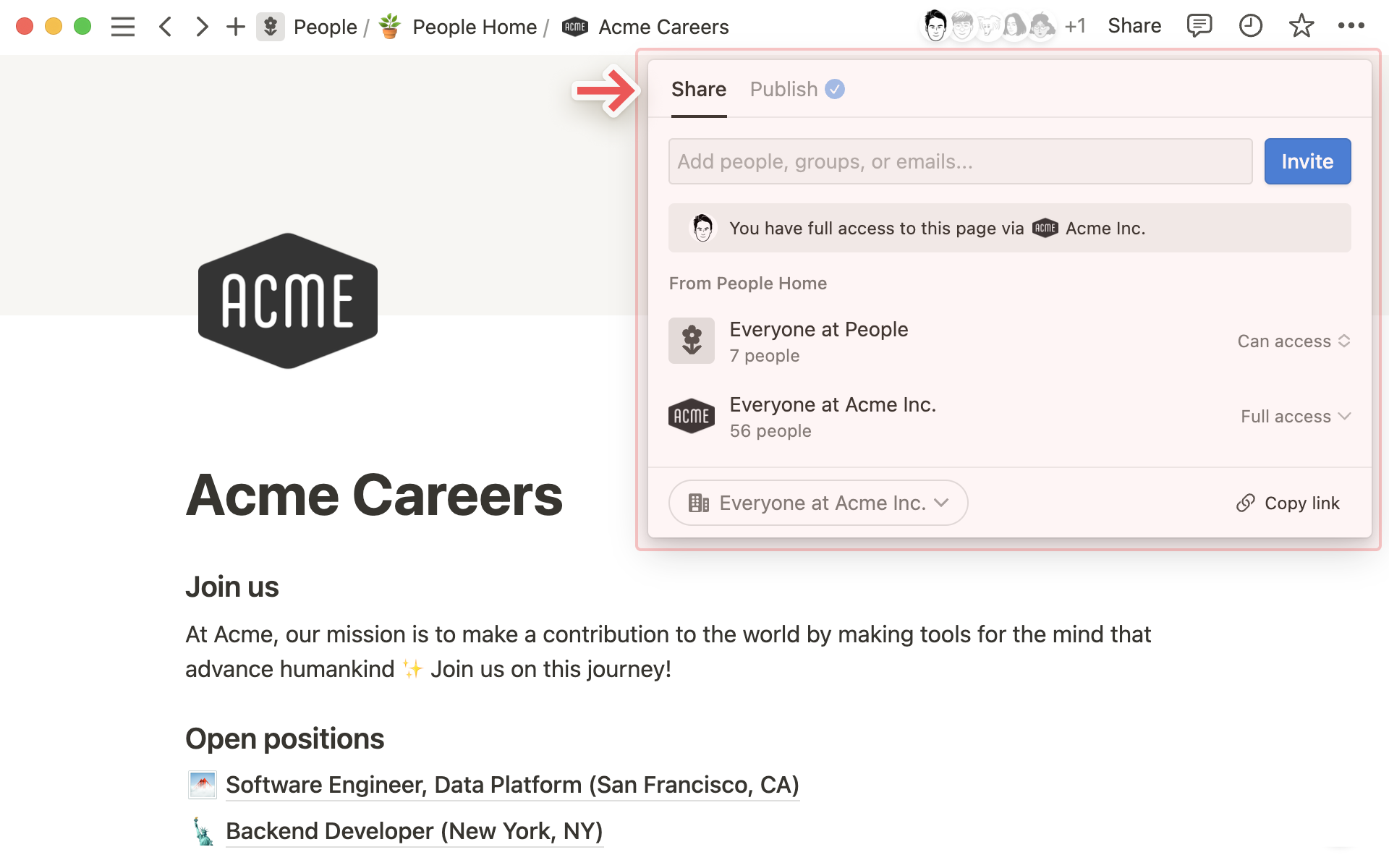
There are different sections of the share menu, the dropdown on the right indicates their level of access.
Using this above example:
Everyone at Engineeringmeans everyone in the teamspace has access to this page.More people with accessare members and guests with access for other reasons, like being in a specific group.stephanie@toolsforthought.xyzis an example of a Page Guest who was invited from outside the workspace — she can only view this page.
At the bottom of the share menu, you can
Copy linkto your clipboard so you can share it with whoever you want. You can control who has access to the page here:Invite onlyAnyone with a link in [workspace]Anyone in [workspace]
Invitelets you add people both inside or outside your workspace to a page using their email address.External folks will be added as guests.
You can assign both guests and other workspace members a level of access using the dropdown menus:
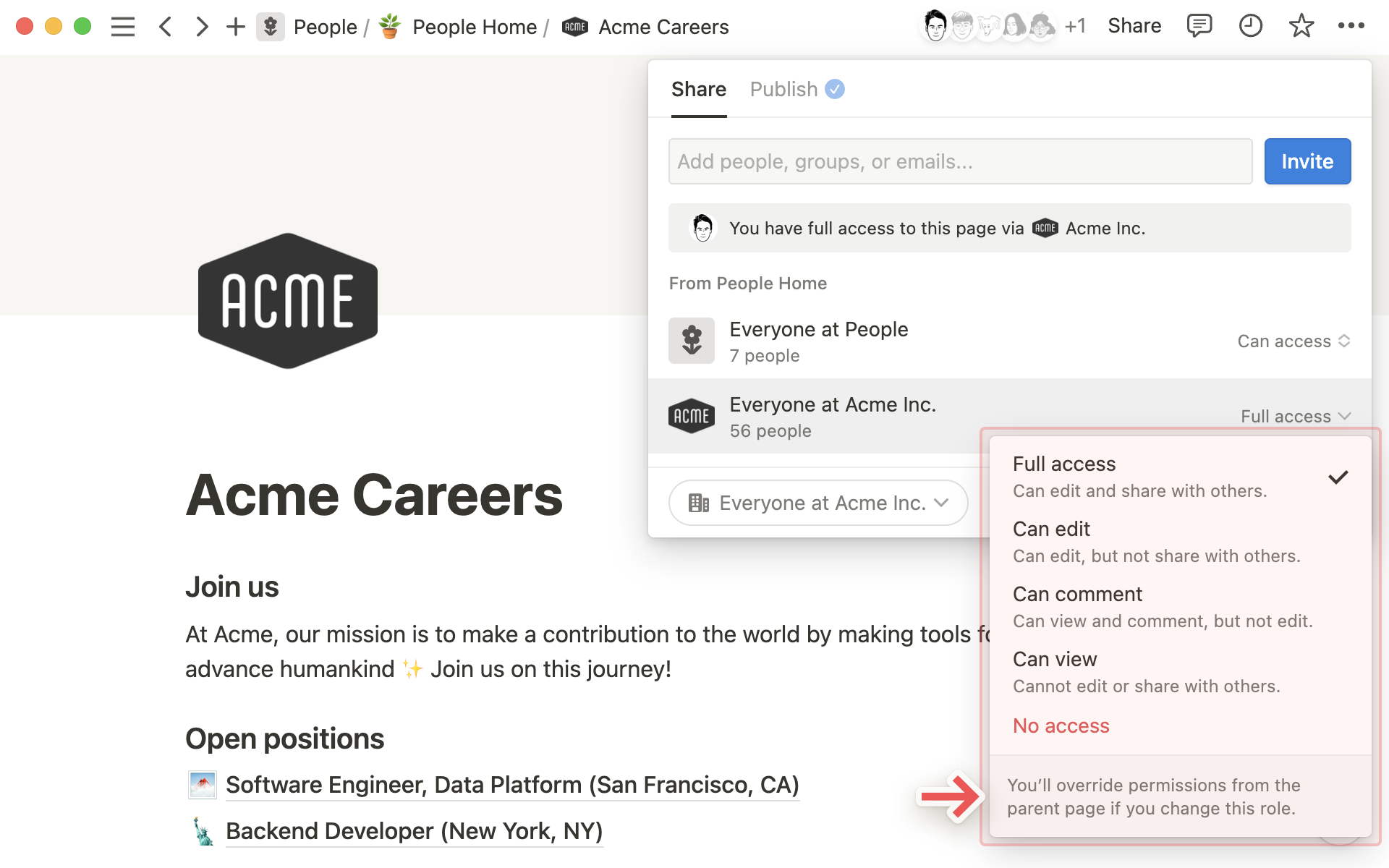
Share with everyone in your workspace
You can collaborate with other people in Notion by adding them as members to your workspace. These can be your teammates at work, friends, or anyone you want to work with on pages. There are a few ways to share Notion pages with all members of your workspace so you can work together:
Create a page in any default teamspace in your sidebar. Hover over the default teamspace's name and click the
+button that appears.Drag a page to a default teamspace in your sidebar. This automatically shares it with everyone.
Share with a teamspace
Teamspaces are a dedicated area for every team within your organization or company. Each teamspace has its own members and permission levels, which can be customized by its teamspace owners. Learn more about adding members and assigning permissions in teamspaces →
You can share Notion pages with any teamspace that you are a member of:
Create a page in a teamspace in your sidebar. Hover over the teamspace's name and click the
+button that appears.Drag a page to a teamspace in your sidebar. This automatically shares it with members of that teamspace.
Share with individual teammates
Sometimes you'll want to share a page with only select other members of your workspace — like a meeting doc you share with your manager, or notes for a small project team.
Click
Shareat the top right of a private page you want to share with these members.Add the members by typing in their email addresses and clicking
Invite. You can set their access levels from the dropdown in the invite window.While searching for people, you'll see names under
In pageorNot in page, indicating if they already have access.
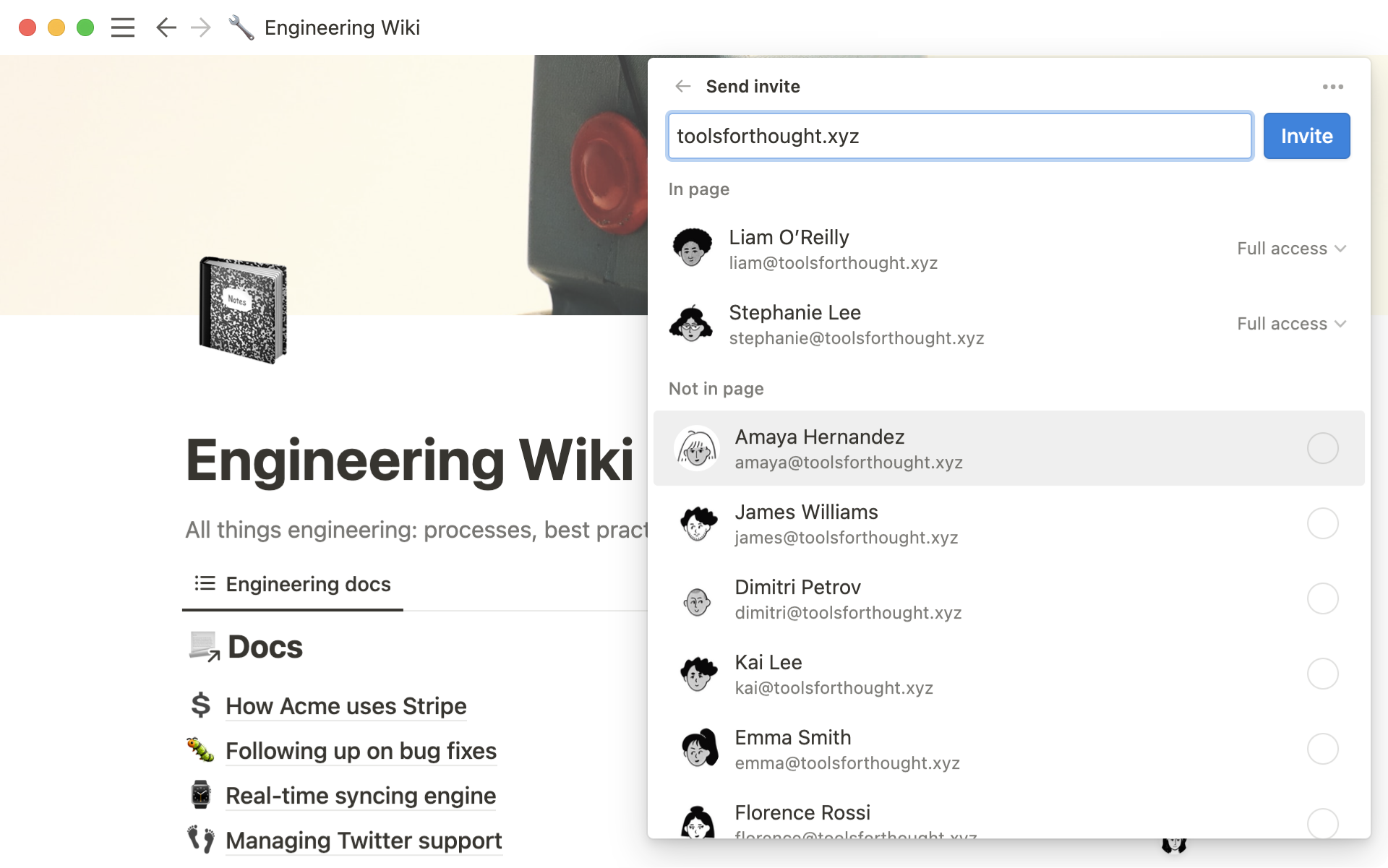
Pages that you share with only a few members but not your entire workspace will show up in the
Sharedsection of your sidebar. Drag them into a teamspace to share them with everyone in that teamspace.If you have more than 7 pages in the
Sharedsection, you can pick which ones you'd like to keep pinned to the sidebar.
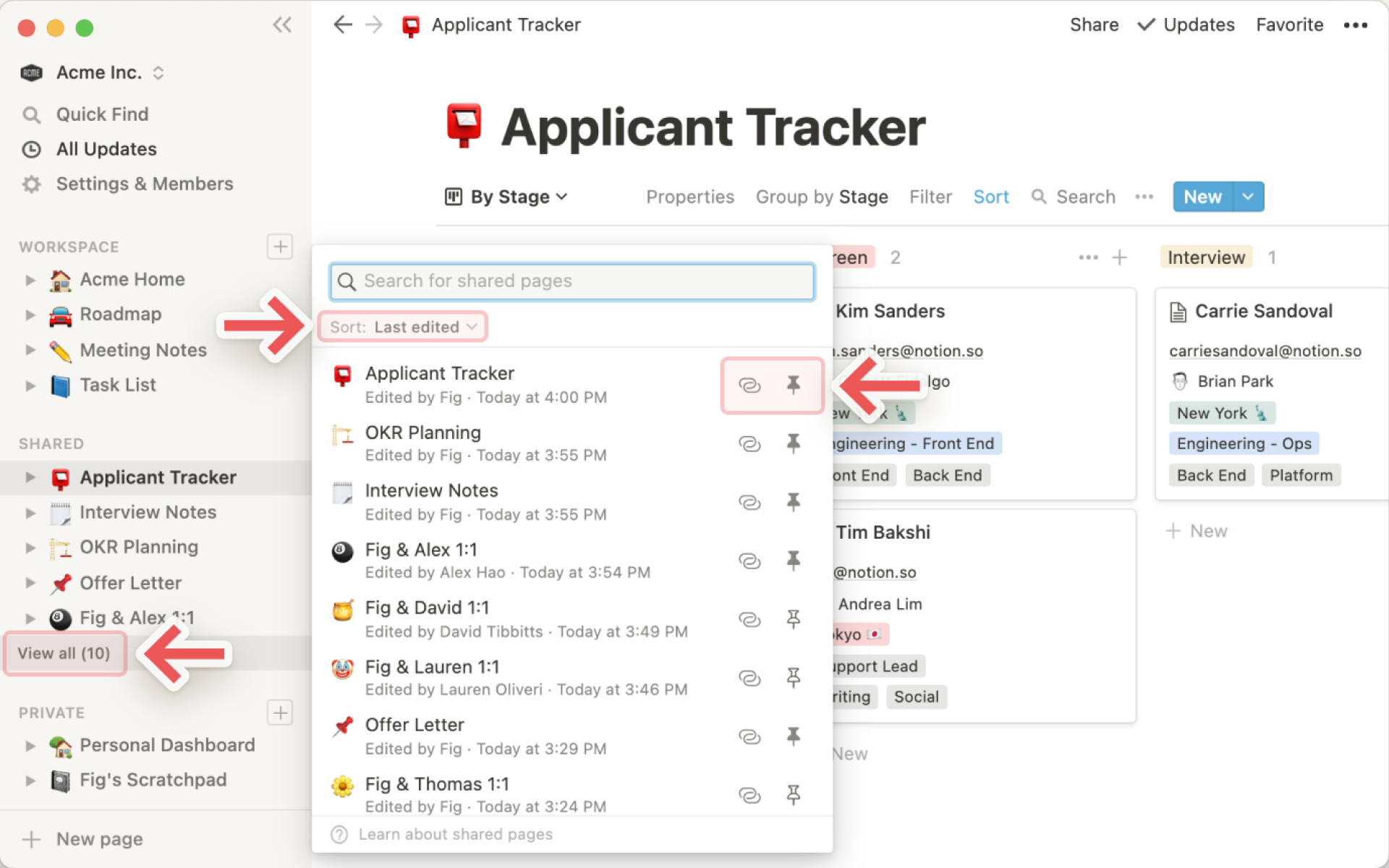
Tip: In the Shared section pop-up, you can also search for shared pages, sort by Relevance or Last edited, and easily copy page links!
Share with groups
To make it easier to share with commonly-used groups (i.e. your company's engineering team or community team), you can create your own member groups and assign them permission to access pages as units.
Here are quick instructions for group sharing:
Go to
Settings & membersand you'll see a list of all your members and guests. Click theGroupsheading at the top of that list.Click
Create a group, give it a name, and add the members you wantTo share a page with a particular group, go to
Shareat the top right of that page, then click theInvitebutton. You'll see your groups listed in the invite pop-up that appears:
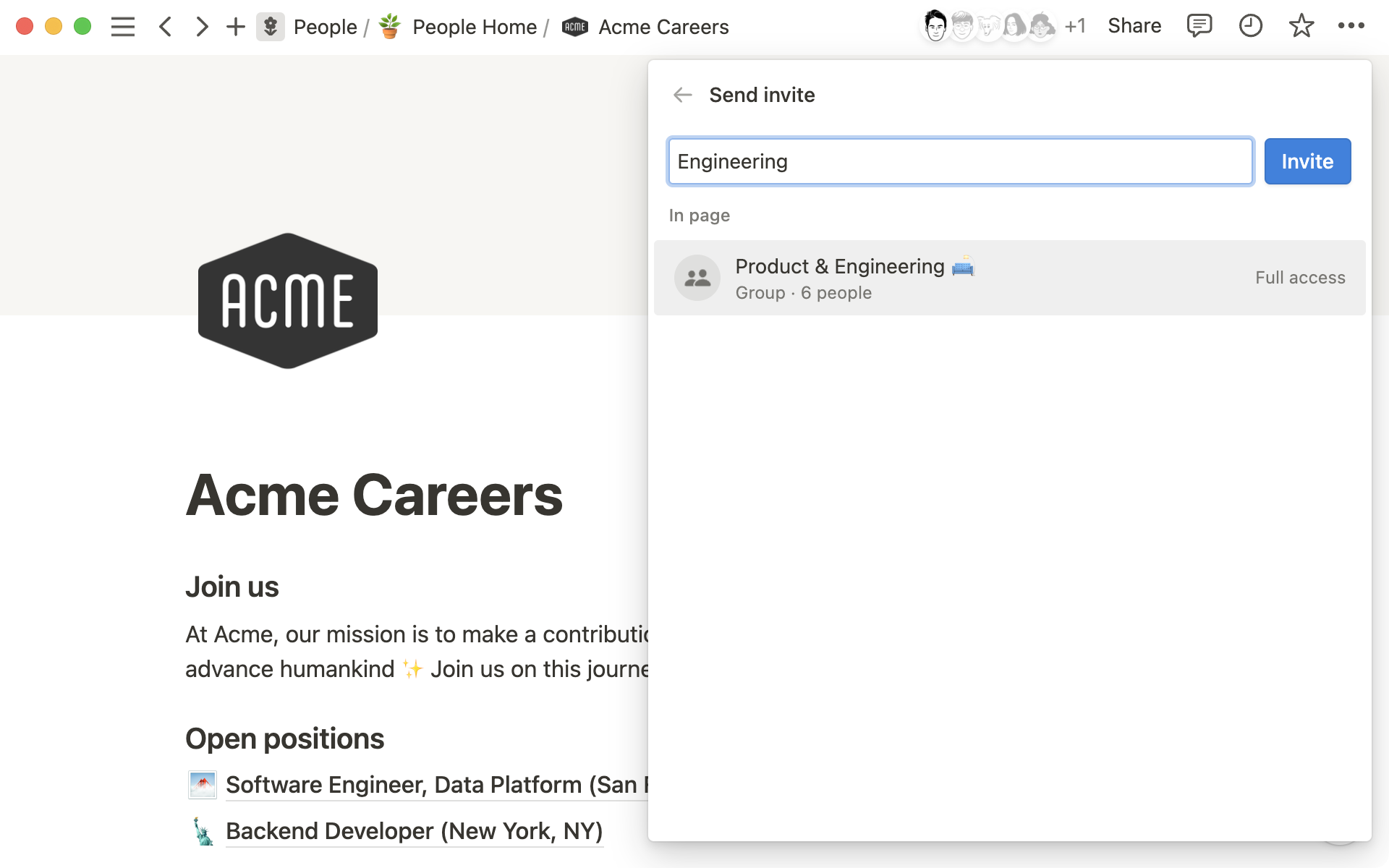
Tip: Everyone at [workspace name] sets the minimum access level on a page for everyone on your team. To give certain people or groups higher access levels, set the access level for Everyone at [workspace name] to Can view or Can comment.
Share outside your team
You can invite people from outside your workspace to join pages as guests. Let's say you want to share a Notion page with an external contractor you've hired. Or perhaps you're the contractor and you want to share a page with a client. This is an ideal solution.
Quick instructions for sharing with guests:
Click
Shareat the top right of the Notion page you want to share externally.Add the members by typing in their email addresses and clicking
Invite.You can set their access levels from the dropdown in the invite window.Whoever you invite this way will receive an email with a link to the page you've invited them to view or edit.
If you want to see all the guests in your workspace and the pages they have permission to access, go to the
Memberssection ofSettings & membersand go to theGueststab.In this same window, you can remove guests from your workspace, change their access levels, or convert them to full members.
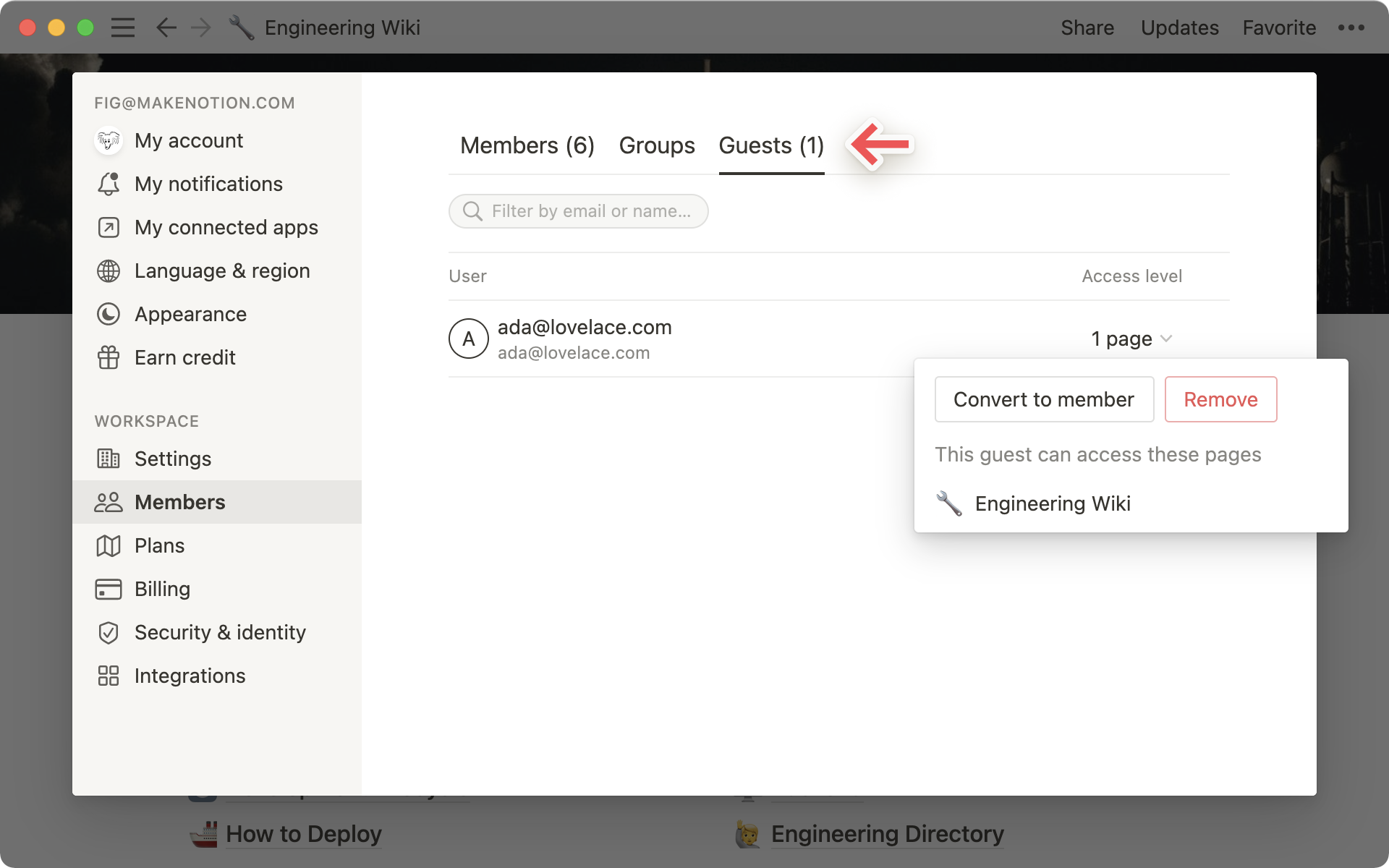
Share to the web
To make a Notion page viewable as a site on the web or to share it with people who don't use Notion, you can turn on Share to the web. Anyone with the link will be able to see it.
Quick instructions for making pages public:
On the page, click
Sharein the top right corner.Under
PublishselectPublish to web.You can optionally toggle on:
Link expires:Allow duplicate as templateAllow editingAllow commentsSearch engine indexing
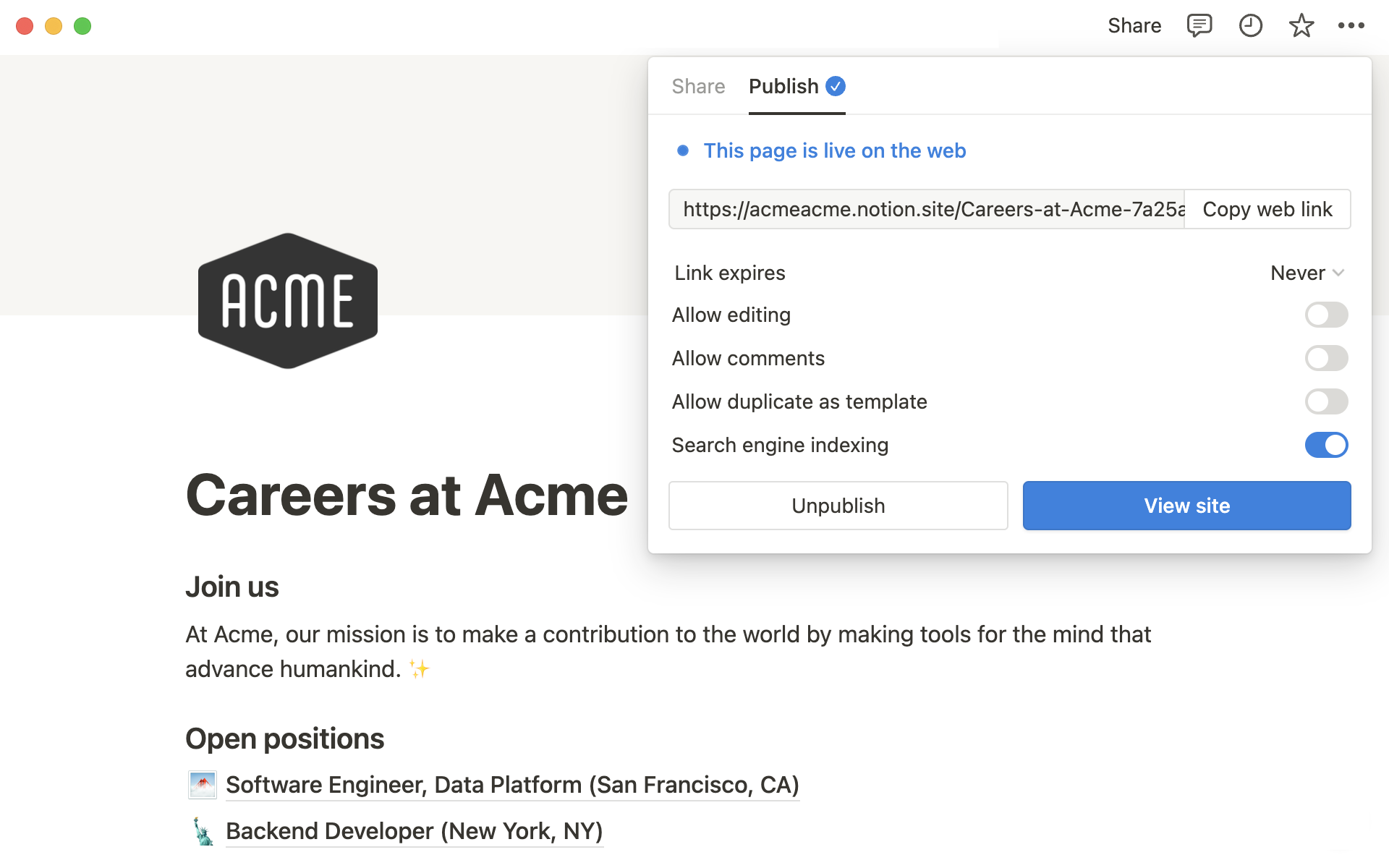
This is where Notion's sharing options get nuanced and granular. For every person or group you share with, you can assign a different level of access. For example, this is helpful if:
You want only a few people to edit a page, while everyone else reads it.
You want some pages to only be visible to a specific team.
You only want to collect comments on a piece of writing.
Note: When you invite someone to a page, they can automatically access all of its sub-pages by default. That being said, you can restrict or expand sub-page permissions!
How to edit permissions
Whenever you invite someone to a page, or click on Share, you'll see right-hand dropdown menus next to people or groups that let you select their level of access: Full access, Can edit, Can comment, and Can view.
Full access: People with full access to a page can edit any of the content it contains and share the page with anyone they want using all the mechanisms in this guide.Can edit: Select this level of access for people or groups who should be able to edit the content on the page, but not share the page.Can edit content: This permission level is only found on database pages. It allows people or groups to create and edit pages within the database, and edit property values for those pages. However, they will not be able to change the structure of the database and its properties, views, sorts or filters. Learn more about databases here →Can comment: Select this level of access for people and groups who should only have the ability to comment on a page's content, not actually edit it. They also can't share the page with others.Can view: People with this level of access can read the content on the page, but not comment on it or edit it. They also can't share the page with others.
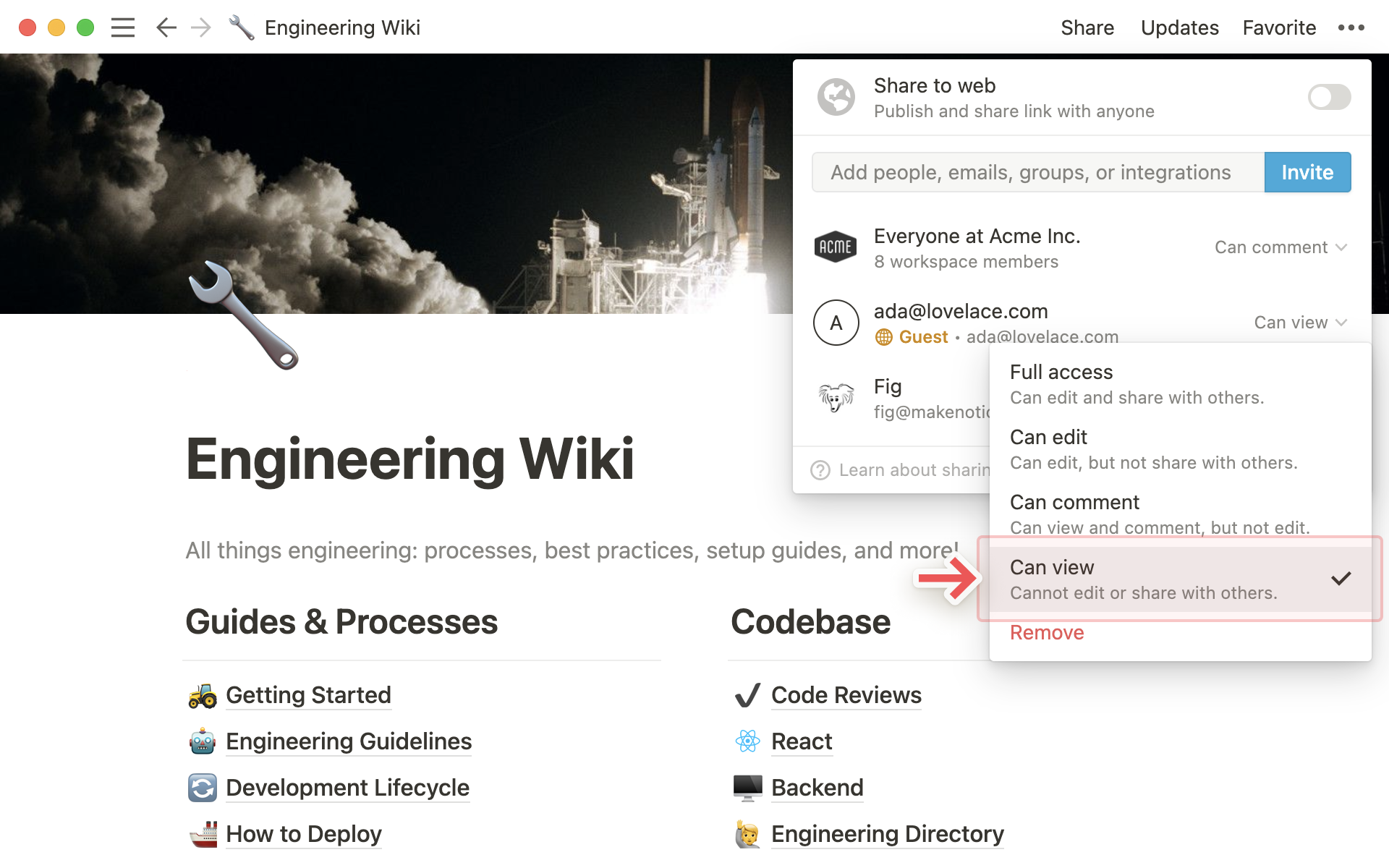
How to restrict, expand & restore sub-page permissions
By default, any page that's nested inside a page (a child page) will inherit the same permissions as the page it's nested in (the parent page). But you can assign higher or lower levels of permission for sub-pages to meet your needs.
For example: In the screenshot below, everyone at Acme Inc. has Can comment access to the Engineering Wiki and all its sub-pages. Fig is the only team member who's able to make edits, or share with more people.
In a sub-page such as the "Engineering Guidelines" page, you may want to expand permissions to allow a member, guest, permission group, or the entire workspace to be higher than
Can comment. In the permission level dropdown for this example, you would selectCan editorFull access.Note that the permission level of "Engineering Guidelines" is determined by the "Engineering Wiki" parent page, but it can be overridden.
In a sub-page, you can restrict permissions to prevent members, guests, permission groups, or the entire workspace from commenting, or from seeing the page at all. In the permission level dropdown for this example, you would select
Can commentorNo access.Note that once access is removed for
Everyone at Acme Inc, now the "Backend" sub-page can only be seen and edited byFigandLauren. Think of it as a "secret page" 🔮
When you restrict the permission levels of a sub-page, a
Restorebutton will appear at the top of yourSharemenu. Use it to revert the permissions back to default, and inherit from the parent page.
Tip: You can create "secret pages" that only certain people or groups can see, by setting the permission level of a sub-page to No access for the people or groups you want to hide the page from.
Stop sharing
If you have full access to a page, you can disable sharing with anyone at any time.
The fastest way is to move the page from
WorkspaceorSharedin your sidebar to thePrivatesection. Make sure this is what you really want to do, though, because everyone else will lose access.Click on
Shareat the top right of the page, and switch off access for your workspace, individuals, groups, or the public. You can also selectRemovefrom the dropdown next to any of these.For guests, click
Shareand then selectRemovefrom the dropdown next to their names. You can also go toSettings & members, scroll down to find the guests you want, click on the dropdown to the right of their names and click theRemovebutton.
Note: People who do not have any access to a page will not see it in their workspace. It might appear in your sidebar, but not in theirs.
You can tell who else has access to a page because their avatars/profile photos can be seen in the bar at the very top of the page.
An avatar appears faded out if that person is not currently looking at the page.
An avatar appears unfaded if the person is currently on the page.
Hovering over an avatar will show you the person's name, email, and when they were last on the page.
Clicking on an active avatar will jump you to the part of the page where they're reading or typing.
When people are collaborating on the same page at the same time, you'll see their avatars move next to the blocks they are looking at or editing.
Click
•••at the top right of any page and look at the bottom of the menu that pops up. You'll see who last edited the page and when.
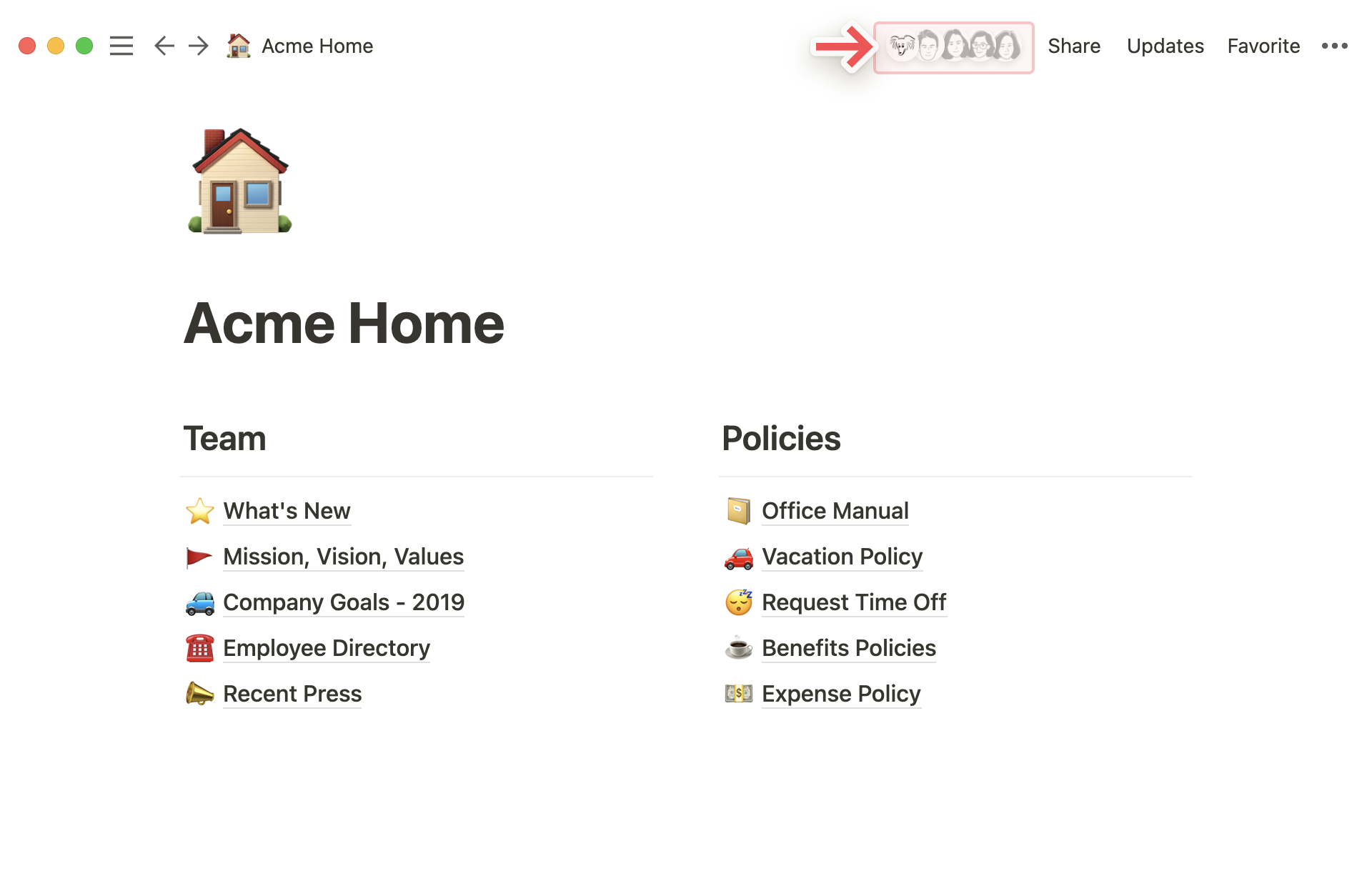
If you don't have access to a page, you'll see No access instead of the page name.
Click this to see a menu where you can leave a message and request access to the page.
This notifies page creators or page editors. They can choose to accept or deny your access request.
If you have an Enterprise Plan subscription, and you're a Workspace owner, you can prevent content from being shared by turning on certain security settings. Contact sales to learn more about our Enterprise plan.
Go to
Settings & membersat the top of your left sidebar.Click
Settingsin the sidebar of the window that pops up.Scroll down to the
Security & identitysection, where you'll these toggle switches:
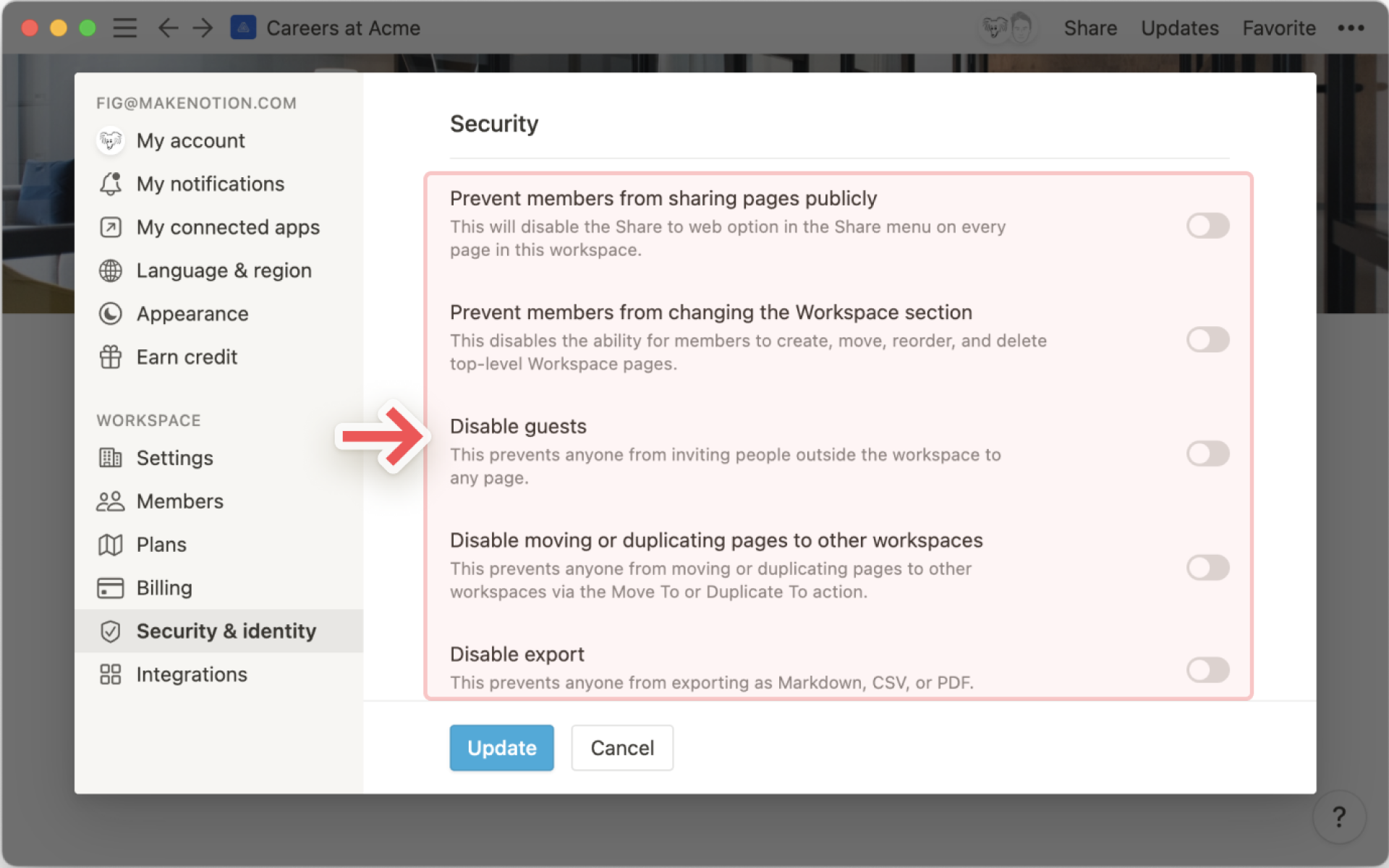
FAQs
I tried adding a guest to my workspace but they were turned into a member automatically. How can I prevent that?
If your workspace is above the guest limit for your plan, new users that you share content with will be automatically added as a member (instead of as a guest) if they have the same organization email domain.
To allow for a new user with the same organization email domain to be added as a guest, you will need to remove existing guests to fall below your plan limit, upgrade to a plan with a higher limit, or work with our sales team (for eligible customers).
If your workspace is above the guest limit for your plan, you may have the Allowed Email Domains setting turned on. When enabled, this feature allows people with that email domain to join your workspace as a member automatically. You can disable this setting in the Settings tab of Settings & Members in the left sidebar.
I want to share a page with a client, but they don't use Notion.
You can enable Share to the web in the Share menu, and share the URL with them. As long as you keep the Search engine indexing setting disabled (always disabled by default), only people with that exact URL will be able to access the page. They'll be able to view the page, even if they don't have a Notion account. However, they won't be able to make any edits, leave comments, or sort/filter a database.
My Export button is missing, it doesn't appear in any menus.
You may have the Disable Export setting enabled in the Settings tab of Settings & Members in your left sidebar. You'll need to be an admin in your workspace, and on desktop to change this.
Can I limit access to different parts of a database? Can you make it so that some people can see certain database views or properties, but not others?
Unfortunately, database permissions don't get quite that granular yet 😓 It’s a legit use case though, and definitely something we want to support in the future. Stay tuned!
